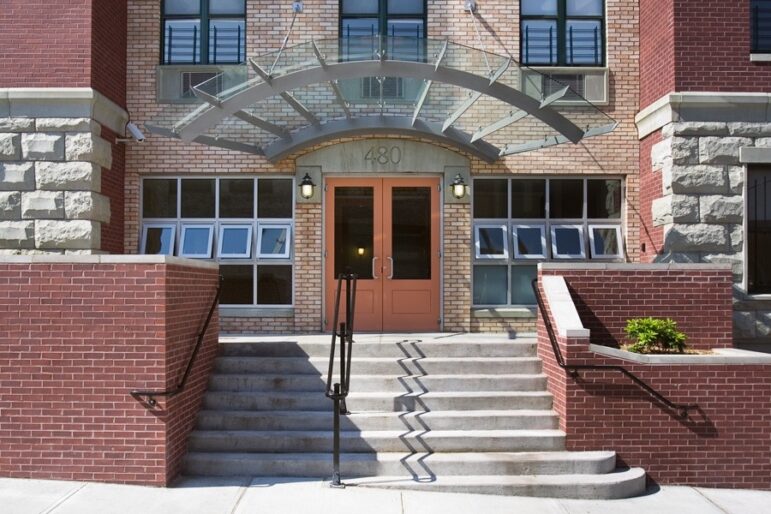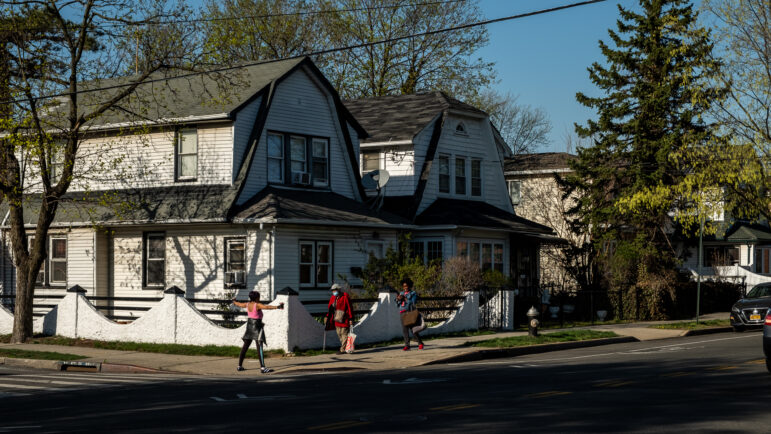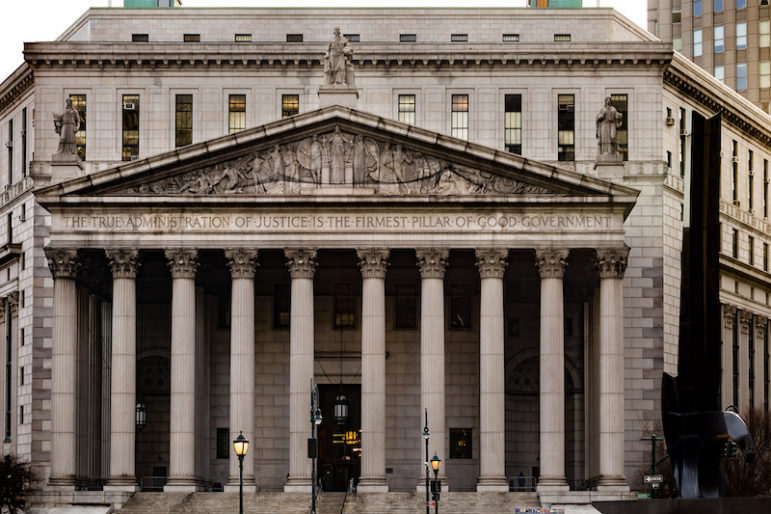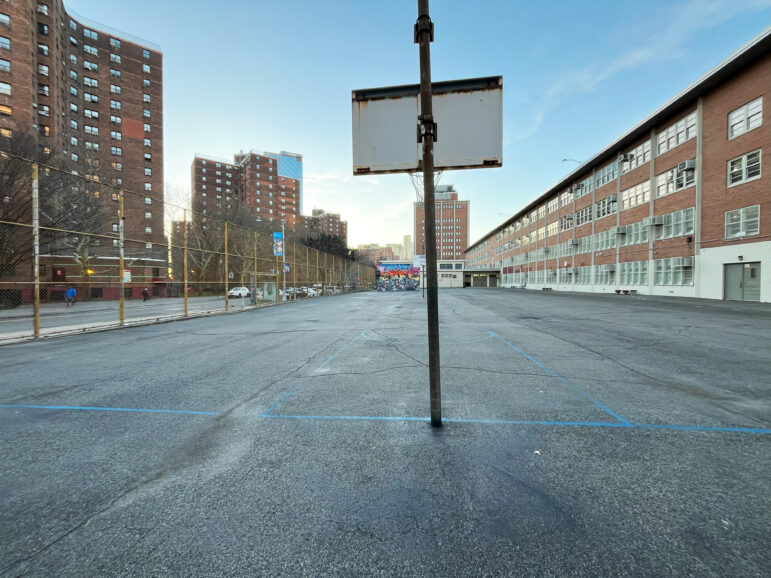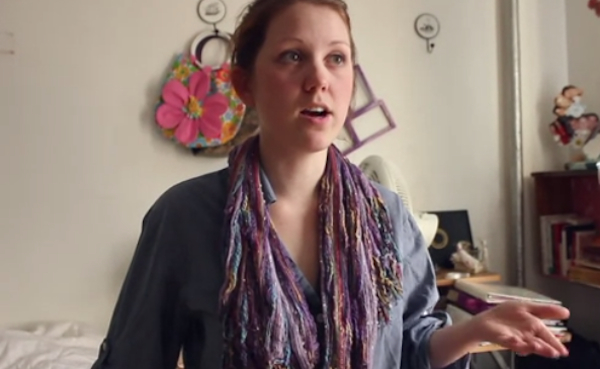
Photo by: Anthony Vecchio
“We told them there was water behind the cupboards and you could see dark spots on the back…but they never came,” says tenant Caitlin Hemmer, referring to the management at 772 St. Nicholas Place.
A heavily pregnant Catherine Nunez had to rush to court to prevent eviction from her apartment at 1 Jacobus Place in Marble Hill just one day before she was scheduled for the Cesarean section of her fourth child in early November 2013.
Nunez’s landlord, Moshe Piller of One Jacobus Place LLC, was trying to evict Nunez from her apartment after she withheld one month of rent. Nunez, frustrated after her toilet remained clogged for almost a month, had had enough and refused to pay. At the time, her three small children could not use the bathroom, and the superintendent failed to send someone to fix it. “All the water used to come out, with everything on the floor,” says Nunez. “It was disgusting!”
The toilet, which was finally fixed, is one of many complaints that Nunez has about her apartment. The front door is cracked and chipped. The bedroom door is unhinged, door knobs have fallen off and there are many cracks on walls throughout the apartment. Furthermore, the bathroom has routine water leaks when it rains, resulting in more damage each time. “The water starts leaking, and the walls start having bubbles, and cracking, [and the ceiling] starts falling down,” says Nunez. “It’s terrible, and every time it rains, it happens.”
Nunez is not the first tenant to complain about Moshe Piller, who did not respond to requests for comment. In 2010, a Huffington Post article reported that Piller’s tenants had “taken him to court more than 95 times in Brooklyn and the Bronx since 1989.” In 2010, Piller was the focus of a four-month investigation by the news site BrooklynInk.
Yet on July 31, 2012, Flushing Savings Bank issued a Mortgage Consolidation, Modification, and Security Agreement in the amount of $4,875,000 to One Jacobus Place LLC, signed by Piller as the sole member and manager.
In a city dominated by renters, bad landlords get their share of bad press in New York. In the 1970s the Village Voice began running an annual list of the 10 worst. Bill de Blasio, during his time as public advocate, maintained an even longer list. Every day in housing court, tenants and landlords battle over rent and repairs.
But behind every landlord there is a bank—whose lending enables the landlord to purchase or refinance a property where other people live. Housing advocates have for decades pressed banks to take a more active role in making sure landlords adhere to the “good repair” clauses that are part of mortgage boilerplate. Now, there is a new push for more accountability by banks.
In a September circular to all banks, the state’s Department of Financial Services reported that, “the number of affordable multifamily properties considered in physical and/or financial distress has been rising in New York State.” DFS said it was considering a new approach to bank examinations that looks more closely at building conditions.
New concerns and new tools
In the last decade, dozens of buildings in poor and working-class neighborhoods became the focus of speculation by investors who believed gentrification would soon bring richer renters and higher rents, and who paid lavish sums to purchase them—putting the buildings under financial strain, often reflected in deteriorating maintenance. This only amplified concerns about the role of banks in distressed properties.
“Banks and a lot of nonbank lenders were making unsustainable loans which led to a lot of harassment and then, when the economy collapsed, a lot of the loans went bust and they stopped taking care of the properties,” says Jaime Weisberg, an advocacy associate at the Association of Neigborhood Housing Developers.
ANHD’s executive director Benjamin Dulchin agrees: “In the run up to the financial crisis sustainable lending standards were largely thrown out the window.”
This led advocates to shift their strategy around building conditions; besides targeting the landlords, they began taking their concerns to the banks as well.
One organization dedicated to preserving affordable housing, the University Neighborhood Housing Program in the Bronx, compiled a list of all the residential properties in the city and tallied the number of housing code violations as well at the debts owed on mortgages and taxes, and generated a score. Called the Building Indicators Project, its aim was “to have an impact on the quality of housing in our neighborhoods by holding banks to account for the type of multifamily lending they do, and by enabling housing organizers and advocates to do their jobs more effectively”, according to Gregory Jost, UNHP’s deputy director.
Banks helped to create the tool. “It was critical to get buy-in from lenders from the beginning so that they see the data as accurate and meaningful in what it’s measuring: specifically, levels of physical and financial distress,” Jost says.
Focus on ‘distressed properties’
The BIP gives every building in the city a score based on their debts and code violations. A BIP score over 800 are considered an indicator of distress. According to an edition of the BIP released in November, some 1,600 residential buildings citywide comprising 36,000 apartments have scores of 800 or higher.
Using the same BIP database, the Association of Neighborhood Housing Developers, an advocacy group for the nonprofit affordable housing industry, recently reported on buildings that have a ratio of 1.5 serious violations for every unit. Serious violations are those with a B or C rating from the city.
ANHD found that nearly a quarter of the residential buildings in some banks’ local portfolios could be considered distressed.
Commercial and savings banks
financing buildings with a 1.5:1 ratio
of serious HPD violations to units
Source: ANHD
* * * * * * *
Because of the size of their real-estate holdings, Chase, Capitol One and Flushing have the most buildings on the list.
A survey by a team of reporters this fall of buildings associated with those banks found different circumstances but common themes—troubled landlords, tenants with little recourse and poor conditions.
Rodents, roaches and more
The problems in some banks’ portfolio might go deeper than properties that are deemed “distressed.” One Jacobus Place, for instance, has 48 violations in 84 units. But tenants say those numbers don’t reflect reality because the landlord reports problems as fixed even when they linger.
Other distressed buildings in Flushing’s portfolio show a similar pattern. On January 10, 2013 Flushing Savings Bank took over the financing of 772 Saint Nicholas Avenue in Hamilton Heights. Flushing Bank issued a $1.24 million mortgage consolidation, modification, and security agreement for the six-story property to Evita Realty Corp., the real estate company that has owned the property since 1981.
Tenant complaints filed with HPD over the past year range from roaches and mice to more dangerous conditions like unsafe wiring and lead paint. According to tenants, Evita Realty Corp. is slow at making repairs. “We told them there was water behind the cupboards and you could see dark spots on the back…but they never came,” says tenant Caitlin Hemmer, referring to the management. According to the HPD website, 772 St. Nicholas Place had 102 violations for its 56 units.
An even more concerning issue to tenants, however, is that quick fixes are standard of Evita Realty Corp. Damage is superficially repaired, but the underlying problem is not rectified. Hemmer claims that when her kitchen ceiling leaked, it was patched up three times, but done quickly and poorly, such that the water leaks continued. The moisture became so intense that a mushroom began growing from her ceiling. Calls to Evita Realty Corp.’s management office requesting comment remain unanswered.
2 Jumel Terrace, a building in Washington Heights, is also financed by Flushing Bank, which issued a mortgage for the property in 1998 and extended it in 2012. The building now has 55 open HPD violations—nuisances like mold, mice and a lack of hot water.
Long-term tenant Sorange Scroggins said in October that she had a leaking ceiling in her kitchen for as long as she can remember and claimed that the management company Friedman LLC hardly makes any repairs. “I had to call 911 in order for them to fix it. I was here cooking and the ceiling, it went whoop and it fell,” she said. “The nice apartments you see in the building are the ones from long time tenants, they have paid and made their own repairs.”
The 48-year-old grandmother was also concerned for the safety of her grandchildren. “The kitchen window is broken and around June the apartment tested positive for lead,” she claimed.
In an interview in October, Kieran McCaffrey, Flushing’s vice president executive of loan originations, said the bank based their lending decisions on three qualifications: credit worthiness, cash flow, and building conditions. McCaffrey acknowledged that Flushing Bank hires a third-party provider, the name of which he did not disclose, to conduct a yearly “drive-by” to check on the status of their properties. Contacted in February, McCaffrey referred questions to another Flushing officer, who did not respond to requests for comment.
Watch a video produced by Hunter College students Derewko Torres and Anthony Vecchio about conditions in a few of the properties financed by Flushing Bank.
* * * * * * *
Tenants: Management not responsive
Capitol One was associated with at least 50 buildings on the BIP list of distressed properties. Some are owned by Liberty Place Property Management/Castellan Real Estate Partners, which manages a large portfolio of buildings in the New York City metropolitan area. Castellan was in the news last summer when Gov. Cuomo’s tenant protection unit subpoenaed the firm. State officials wouldn’t provide a copy of the subpoena to City Limits. Castellan recently agreed to a settlement under which it will be monitored for three years and pay back tenants from whom it demanded proof of citizenship.
But tenants of Castellan buildings had other complaints. A tenant who gave her first name, Sabel, who lives in a studio apartment on the first floor of the Liberty Place building at 133 West 145th Street in Harlem, said in October that she’d been without heat for a few months. Now, the building has 40 open HPD violations. Liberty Place has a sign posted in the lobby that lists a number for tenants to call if ever they need any repairs done. However, according to multiple residents, their calls to that number are never answered. More often than not, residents are forced to make their own repairs in their apartments.
That was a story echoed by two tenants at 520 West 156th Street in Washington Heights, which is also owned by Liberty Place Property Management. While those tenants said heat and hot water weren’t a problem, they told us that they had been having problems with their intercom system and the locks on their doors, which made them feel very unsafe. After multiple attempts to reach Liberty Place failed, they decided they were going to have to fix it on their own. The property on 156th Street has a modest 21 violations, according to the HPD database.
133 West 145th Street, was purchased by Castellan Realty Corp in 2012, when they signed a mortgage for $2.4 million with Capital One. 520 West 156th street was first mortgaged with Capitol One in 2012 by another company, who sold the building to Castellan later that year.
At another Capitol One-financed building, 105 East Clarke Place in the Bronx, a tenant named Raul played us a recording of the voicemail he got when he called the management company for his building to prove his point; “We don’t have a number to call in case of emergencies, the super is suppose to give us a telephone number for emergencies,” he said. “The super is always disappearing.”
105 East Clark Place has 80 open HPD violations ranging from broken window guards to roaches in apartments. It’s owned by 105 East Clarke Place Associates, LLC, which borrowed from other banks before obtaining more than $2.8 million in financing from Capitol One in 2011.
This fall, some of Liberty Place’s properties were showing signs of improvement. A woman in the lobby of the West 156th Street property, who didn’t give her name, told us that while her living conditions were poor in the past, they have been greatly improving. She recounted that numerous problems in the building were fixed within the past couple of weeks.
In a statement, the bank said, “Capital One is committed to ensuring that tenants in all bank-financed properties live in buildings that are safe and well-maintained. We were an early adopter of Building Indicator Project data, which we’ve found to be an important tool in our efforts to ensure that the properties we finance remain in a state of good repair.”
The bank continued: “We have taken a proactive approach to asset management and responsible underwriting and, as a result, less than two percent of Capital One-financed buildings register on the BIP report. Our goal is to make sure all issues with the properties we finance are remedied. We will continue to work with our borrowers, government agencies and nonprofit partners to ensure their safety and good condition.”
Watch a video produced by Hunter College students Bryan Urbsaitis and Jasmin Tepale about conditions in a few of the properties financed by Capitol One.
* * * * * * *
Mortgages sold, and sold again
Banks sometimes come to hold mortgages they didn’t originally grant, and sometimes sell those notes off to investors. After it bought Washington Mutual’s portfolio following WaMu’s collapse in 2008, JP Morgan Chase came to hold mortgages on at least seven properties owned by Emmanuel Ku, a landlord who’s frequently been the subject of lawsuits and bad press..
In December 2010, according to legal documents, Ku stopped making mortgage payments for one of the properties, 2866 Frederick Douglass Boulevard in Harlem; Chase began a foreclosure action in early 2011. N.Y. Brooklyn Investor II LLC bought the bundled mortgages in August and the following month assigned the investment company FTBK Investors II LLC as their trustee. FTBK and Ku have been facing off in court over the foreclosure action ever since.
In the meantime, tenants have suffered. The six-floor building currently has 49 open housing code violations, 26 of which New York City regulators consider “immediately hazardous.” Of those class C violations, 20 are for peeling lead based paint, some of which have been open since HPD first cited them in 2004.
Other Ku-owned buildings involved in the WaMu to Chase to FTBK transfer also report poor conditions. At a four-floor walk-up brick building at 414 Melrose Street in Bushwick, Carmen Alicea says that she has had to buy her own construction supplies out of pocket and pays an outside contractor to do home repairs. “There is no heat and I have a newborn,” she says. “We had to move into the living room, and I had to get an electric heater. We have mice.”
Evelyn Garcia, who lives on the top floor, struggles with asthma and is forced to walk up and down the stairs to let people in because the doorbell does not work. The second floor is dark and has no lighting. Her bathroom displays an accumulation of mold and mildew on the walls. “The super just paints over the mold, and it keeps coming back.” The building has 69 violations, six of which serious enough to be considered life-threatening.
Because Chase sold the notes on the Ku buildings to investors—a common move by banks in the era of mortgage securitization—it’s not entirely clear which financial entity is responsible for the condition of the buildings. Quarterly statements from the city’s Department of Finance indicate that Chase was responsible for property tax payments on four of the five properties as recently as October, but according to Mike Fusco, a Chase spokesperson, Ku has not been a client at the bank for two years.
“We regularly monitor our clients to ensure they are maintaining their properties by checking their annual operating statements and physically visiting the properties,” Fusco said in a statement.
Phone calls and emails to FTBK and law firms associated with the foreclosure cases were not returned. Through an attorney, Ku declined to comment.
Meanwhile, 1408 Bushwick Avenue, a Ku-owned property in Brooklyn, is filled with tenants who have been trying for years to get their situations improved. This eight-family dwelling has eleven C violations, ranging from missing smoke and carbon monoxide detectors, stove gas leakages, a partial ceiling collapse, mice, and inadequate heating.
Tenant Shavonne Branch directs attention to a chunk of unplastered wood ceiling revealing an exposed light fixture. Water bubbles seeped through the walls, paint peelings, and the bathroom walls covered in mold.
“I’m afraid to use my stove, It leaks gas. I had to buy a heater.” says Nwayieze Ndukye, another tenant. “The main thing is having so many issues in the apartment. The electricity not working, the heating was just turned on two days ago. There have been calls for quite a long time. Trying to contact the landlord is near to impossible.”
New regulations coming?
The federal Community Reinvestment Act compels banks to lend responsibly in low-income areas where they accept deposits, and banks are graded periodically on their performance. In a 2012 CRA evaluation report prepared by federal bank examiners, Flushing Bank received an overall “satisfactory” grade. That same year, Capitol One received a grade of “outstanding” and Chase got a “satisfactory” score.
In its September circular, the state Department of Financial Services said it was considering revising guidelines for rating banks’ compliance with CRA, a test that very few banks now fail. DFS says it may now consider “whether banks proactively monitor their loan portfolios, including whether multifamily buildings are properly maintained and do not have multiple and egregious building code violations.” A DFS spokesman says a final policy will be issued soon.
Advocates recognize that banks’ powers, while substantial, are not limitless—and that landlords have the lion’s share of responsibility for building conditions. Better behavior by banks will not replace the need for strong rent regulations and sound housing-code enforcement.
While mortgage holders technically have the power to foreclose on a building for violating standard “good repair” clauses in their lending agreements, in practice that’s difficult. Once a bank has decided to lend money, it lacks much real power unless a building goes into default or applies for a refinancing.
That puts the onus on lending decisions, when banks wield tremendous power. What advocates want, ANHD’s Weisberg says, is pretty simple: “We want banks at the table taking responsibility for the loans they’re making.”


